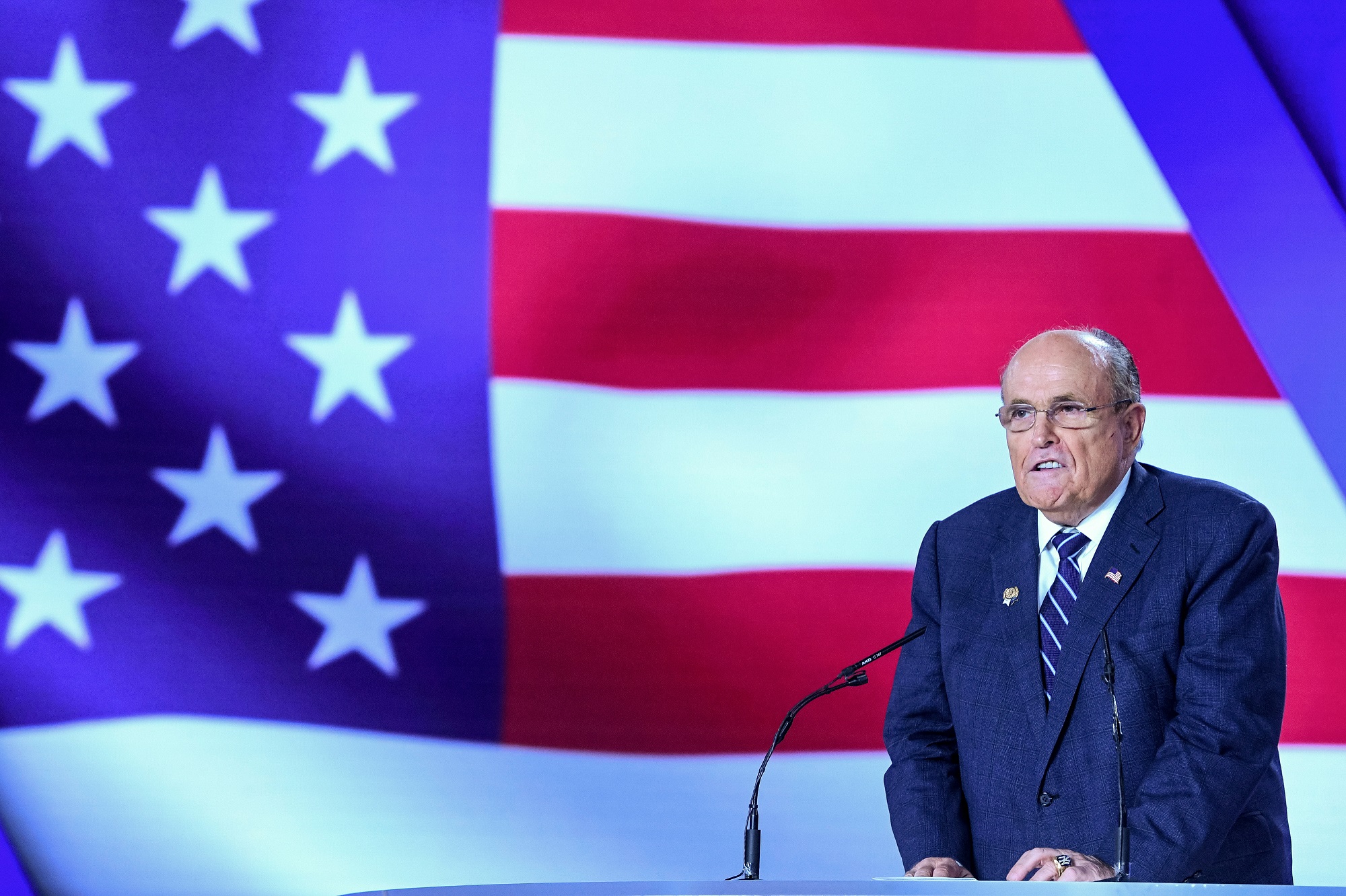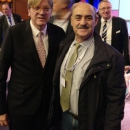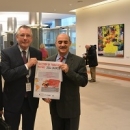As soon as Maryam Rajavi, her face beaming across a giant screen, finished speaking, the sky above hundreds of her supporters in the United States filled with red, white and green confetti – the colours of the Iranian flag.
Dressed in a glossy, dark blue suit and matching scarf tied loosely around her neck – a modest way to wear the hijab that went out of style decades ago in the Middle East – Rajavi had just accused the Iranian government of “terrorism and belligerence”.
“Iran Maryam, Maryam Iran,” the protesters chanted back, holding up posters of Rajavi in a show of admiration bordering on religious devotion to the leader of the Iranian Mujahideen-e Khalq, commonly referred to as MEK or PMOI.
Dressed in yellow, the MEK supporters were lively but disciplined, standing in military formations as they stared up at the screen outside the US State Department building in Washington.
They waved pre-Islamic Revolution Iranian flags, which feature a golden lion brandishing a sword instead of the name of God in Arabic script that adorns the country’s emblem today.
Critics have described the Iranian opposition group as a “totalitarian cult“, voicing concerns about its growing clout in the halls of power in the US capital. Only seven short years ago, the US State Department listed the MEK as a terrorist organisation – and the group’s sordid reputation is something Rajavi and her followers are acutely aware of.
At the 21 June demonstration, Rajavi even acknowledged it, accusing the MEK’s detractors of siding with the Iranian government and carrying out a “disgraceful demonisation campaign” against the group. That effort, she said in Farsi in the video, which was accompanied by English subtitles, “seeks to perpetuate the narrative that the people of Iran are better off with the theocratic rule of the mullahs”.
In her brief speech via video feed, Rajavi also thanked her “friends” in the US. Today, they include representatives, senators, ex-generals, former ambassadors and current policymakers of all political stripes.
In fact, two of Donald Trump’s right-hand men have been on the MEK’s payroll: National Security Adviser John Bolton and the president’s personal lawyer, Rudy Giuliani, have both charged hefty fees to speak at MEK rallies in the past few years.

For their part, the MEK protesters, standing in front of the same building that labelled their organisation a terrorist group in 1997, were making demands of the US government: “US, US, take action; mullahs must get more sanctions,” they shouted. “#Free Iran” was spelled out in golden balloons in the crowd.
Beyond Giuliani and Bolton, lawmakers from both major American political parties have lauded the MEK as a pro-democracy movement despite its checkered past.
“It’s just ridiculous that they’ve been able to get the influence that they have had in the US,” said Barbara Slavin, director of the Future of Iran Initiative at the Atlantic Council, a Washington-based think tank.
“I think that’s primarily due to the money … that they pay lobbyists to press their case,” she told MEE. “They’ve had some very influential people like John Bolton and Rudy Giuliani who have taken their side.”
Giuliani showed up at an MEK podium again this month, headlining a conference in Albania, where the dissidents are now based. The former New York City mayor described the group as a “government-in-exile”, saying it is a ready-to-go alternative to lead the country if the Iranian government falls.
“We don’t have to say, ‘What could be worse?’ We know that there is something much better,” said Giuliani, who has publicly entertained and backed the prospect of regime change in Tehran.
He went on to joke that Rajavi has more support than he does in the US Congress – and judging by the group’s influence among powerbrokers in Washington, he may be right.
Bipartisan support
Over the years, Senior House Democrats Eliot Engel and Brad Sherman, Republican Congressman Tom McClintock, GOP Senator John Cornyn, Senate Democrats Gary Peters and Jeanne Shaheen, and late Senator John McCain have all attended events linked to the MEK and spoken in its favour.
At the rally in Washington last month, both Democratic and Republican politicians praised the group’s struggle against the Iranian government.
Since being removed from Washington’s list of foreign terrorist organisations in 2012, the MEK has taken advantage of its ability to operate legally in the country – and a growing hostility towards Iran – to court policymakers.
“Bashing Iran is good politics in certain circles… If there is a possible financial incentive as well, it becomes easy for a lot of lawmakers to sign up,” said Ryan Costello, policy director at the National Iranian American Council (NIAC), a Washington-based advocacy group.
Last month, key legislators and former officials delivered messages of support at the MEK gathering in Washington, including Senator Bob Menendez, the top Democrat on the Committee on Foreign Relations.
“Thank you for continuing to highlight the plight of Iranians under an oppressive, brutal regime,” Menendez said in a written statement that was read out during the demonstration. “I share your vision for a better future for Iran and all Iranians.”
The rally came less than 24 hours after Trump ordered, then cancelled, military strikes against Iran amid escalating tensions between the two countries. The New York Times reported at the time that Bolton was one of the top White House officials encouraging military action.
Bolton, a regular speaker at MEK gatherings, shares the group’s view that the Iranian regime cannot be reformed and instead must be toppled. At a MEK conference in Paris in 2017, a few months before he joined the Trump administration, Bolton told the crowd they would be celebrating the fall of the Iranian government before 2019.
“I have said for over 10 years since coming to these events that the declared policy of the United States of America should be the overthrow of the mullahs’ regime in Tehran,” he said at the time.
Several speakers at last month’s rally also stressed that the MEK is the right replacement for the government in Tehran. “We need a new regime, and that regime is you, the MEK,” Bill Richardson, a former governor of New Mexico and US ambassador to the UN from 1997 to 1998, told the crowd.
The Organization of Iranian American Communities (OIAC), a US-based, MEK-linked advocacy group, did not return MEE’s multiple requests for an interview about its lobbying efforts in the US.
Asked if the MEK has enough legitimacy to be an alternative to the Iranian government, as some of the group’s backers have said, Slavin told MEE: “No, not at all.”
But she added that not all the lawmakers who speak at MEK events are necessarily aware of the group’s history or supportive of the organisation itself. “They figure out, this group is opposed to the Iranian regime,” Slavin said. “They don’t look at the fine print; they don’t examine the history of the group.”
MEK history
The MEK started in Iran in 1965 as an ideologically driven, socialist and Islamist movement opposed to the dictatorial rule of Shah Mohammad Reza Pahlavi. It joined the ranks of the Islamic Revolution in 1979 but ran afoul of the uprising’s leader Ruhollah Khomeini shortly after Pahlavi’s fall.
After facing a deadly crackdown by Iran’s new authorities, the MEK embarked on a series of attacks on government officials and security forces. The group’s members, led by Maryam Rajavi’s husband, Massoud Rajavi, went into exile and eventually settled in Iraq in 1986. There, they sided with Saddam Hussein in his war against their home country.
The Iran-Iraq war raged from 1980 to 1988, as hundreds of thousands of people were killed and Iraqi forces openly used chemical weapons in battle. In a late stage of the war, MEK militants were at the forefront, leading a major incursion into Iranian territory, which was repelled by the country’s military in 1988.
After the war, the MEK remained in Iraq, and according to some of its critics, including NIAC, the group helped Iraqi forces brutally put down Kurdish and Shia uprisings in the early 1990s – accusations that the MEK rejects.
‘They don’t have a following in Iran; in fact, they are widely detested for siding with the regime of Saddam Hussein during the Iran-Iraq war’
– Barbara Slavin, Atlantic Council
During the 2003 US-led invasion of Iraq that toppled Hussein, American forces bombed MEK bases in the country before reaching a ceasefire agreement with the group. Massoud Rajavi disappeared that year, and his whereabouts remain unknown, putting Maryam alone in charge of the organisation.
Starting in 2009, the Iraqi government became more openly hostile to the MEK amid growing Iranian influence in Baghdad. As a result, the US led efforts to get the group’s members out of Iraq and shutter their main base at Camp Ashraf outside the capital, where the group’s members were confined after the invasion.
Once out of Iraq, the MEK began to resettle in Albania in 2013. A year earlier, former US Secretary of State Hillary Clinton removed the group from the State Department’s terrorist blacklist – 15 years after it was originally added – allowing its members to work openly in the US.
During the debate about legalising the MEK in the US, New York Magazine contributor Elizabeth Rubin presciently warned that the group may use its new status to get Washington into war with Tehran.
“If the group is taken off the terrorist list, it will be able to freely lobby the American government under the guise of an Iranian democracy movement,” she wrote in 2011, comparing it to the influence Iraqi exiles exerted on the US decision to invade Iraq.
“Recent history has shown that the United States often ends up misguidedly supporting not only the wrong exile groups in the Middle East, but the least relevant ones.”
Blacklisting and popularity
But not everyone views the MEK in a negative light, as anti-Iran hawks have questioned why the group ended up on the US’s terrorist blacklist in the first place.
Raymond Tanter, a political science professor who served on the White House’s National Security Council in the early 1980s, said he studied the history of the group and is convinced it is on the “right side of justice”.
In a recent interview with MEE, Tanter said former President Bill Clinton placed the Iranian dissidents on the list of foreign terrorist organisations in 1997 to appease Tehran. “They were there because the Clinton administration wanted to do a favour for some of the so-called ‘moderates’ who had been elected in Iran,” he said.
“[Supreme leader Ali] Khamenei was making sounds as [if] he was willing to negotiate, but those sounds became very, very hollow and nothing came of that.”
Tanter said he avoids using the term MEK because of its affiliation with the State Department’s blacklist, preferring to go with PMOI, which stands for the People’s Mujahideen of Iran.

Tanter told MEE that bipartisan support for the group stems mostly from the organising efforts of the OIAC advocacy group. He said the OIAC is composed of Iranian Americans from across the US, including many white-collar professionals.
Still, support in the halls of Congress does not necessarily translate into tangible influence on the ground. MEK’s critics say the group has no representation inside Iran itself, where the people loathe the movement because of its militant history.
“They don’t have a following in Iran; in fact, they are widely detested for siding with the regime of Saddam Hussein during the Iran-Iraq war,” Slavin said. “They have no constituency in the country.”
‘Attention paid is an indicator of the significance of the PMOI and the larger NCRI have in Iran’
– Raymond Tanter, political science professor
With a lack of independent reporting in Iran and the underground nature of MEK activities there, it is difficult to ascertain what level of support the group has among Iranians.
Tanter, however, said the MEK’s popularity can be measured by the Iranian government’s stated concern about it. Citing recent research by his students at Georgetown University, Tanter said the Iranian government incessantly mentions the MEK. “Attention paid is an indicator of the significance of the PMOI and the larger NCRI have in Iran,” he said.
Slavin dismissed that argument, however, saying the Iranian government shows concern about the MEK because it views the group as a proxy for Saudi Arabia and Israel. “The MEK has committed acts of terrorism in Iran; let’s be real about this,” Slavin told MEE.
Militant past
Seven years ago, NBC News cited two US officials as saying that Israeli-trained MEK operatives were behind the assassination of five Iranian nuclear scientists between 2007 and 2012. The group denied the report at the time, calling it a “sheer lie“.
Still, the MEK has been accused of being responsible for a string of attacks throughout its history.
In 2006, a US State Department report said the MEK carried out a series of deadly attacks in Iran, blaming the movement for a 1981 bombing in Tehran that claimed the lives of dozens of top Iranian officials, including Chief Justice Mohammad Beheshti. The group also openly conducted violent raids on Iranian embassies across the world in 1992.
Moreover, in the pre-revolution era in Iran, the MEK was behind “bombings and shootings directed against American military personnel stationed in Iran”, former US State Department official Daniel Benjamin wrote in a Politico column in 2016.
But that militant past is behind the MEK now, said Kazem Kazerounian, an engineering professor at the University of Connecticut who spoke at the pro-MEK rally in Washington in June. Kazerounian called the movement an “organised, legitimate resistance to the tyranny of the Iranian regime”.
“Currently, they’re not violent; they’re not a military organisation,” he told MEE. Kazerounian said members of the group are the “key organisers” of peaceful protests inside Iran, and added that the MEK’s ongoing struggle against the Iranian government gives it credibility.
“In the lack of possibility of having a democratic election – which actually we would like to get as soon as this regime falls – resistance is the basis of legitimacy of the [MEK-dominated] National Council of Resistance of Iran,” Kazerounian said.
Yet for a group that advocates gender equality and says it is the main pro-democracy Iranian faction, the MEK does little to hide its ties to the ultraconservative, autocratic government of Saudi Arabia.
MEK rallies often feature pro-Saudi speakers and sometimes even Saudi officials. For instance, Turki al-Faisal, a Saudi prince, former intelligence chief and key diplomat, addressed MEK rallies in Paris in 2016 and 2017, prompting accusations from Tehran that Riyadh supports terrorism.
Salman al-Ansari, president of the Saudi American Public Relations Affairs Committee, a pro-Riyadh lobby group in Washington, also spoke at the MEK conference in Albania on 13 July. He was repeatedly interrupted by cheers from MEK supporters as he bashed Iran in both Arabic and Farsi.
“I tell you clearly, as a Saudi citizen who loves and adores his country and an Arab proud of his Arabism and a Muslim honoured by his religion… we are all Ashrafi,” he said, paying tribute to the MEK’s base in Albania, known as Camp Ashraf-3.
Cult of Rajavi
The Saudis are not the only foreign officials to attend MEK events.
Former Canadian prime minister Stephen Harper spoke at the group’s conference this month in Albania, where he was joined by dozens of legislators and ex-ministers from around the world, including former US senator and Democratic vice-presidential candidate Joe Lieberman and parliament members from across the Middle East.
Most of the speakers denounced Iran and sang the praises of Maryam Rajavi and the MEK.
But Rajavi was not always so revered in Western capitals. In 2003, she was briefly detained in Paris along with dozens of MEK members on terrorism charges. A decade later, she released a 10-point plan for the MEK in which she pledged support for free elections, gender equality, abolishing the death penalty and ending Iran’s nuclear programme.
Still, one provision of the manifesto seemed to address lingering concerns among the MEK’s Western backers about the group’s communist ideology – vowing to respect private property and a free-market economy.

The 2006 State Department report says the MEK mixes “Marxism, feminism, nationalism and Islam”. Indeed, the group’s original logo showcases communist symbols, including a sickle and red star, below a verse from the Quran that praises those who struggle – the mujahideen.
The group’s leftist beliefs may appear to make it a strange bedfellow of right-wing hawks such as Bolton and Harper. But Tanter, the political science professor, said he has spoken to many MEK members and found them to be to the “right of” US Senator Bernie Sanders, who describes himself as a Democratic socialist.
Ideology aside, rights groups have decried the MEK’s treatment of its own members. The movement requires complete devotion to the Rajavis and the organisation, and a 2005 Human Rights Watch report accused the group of asking its followers to divorce their spouses to be fully dedicated to the MEK.
HRW also said the group has committed violations “ranging from detention and persecution of ordinary members wishing to leave the organisation, to lengthy solitary confinements, severe beatings, and torture of dissident members”.
In 2009, Rand Corporation, a California-based think-tank, said the MEK started demanding “near-religious devotion to the Rajavis” from its members in the 1980s. In addition, the MEK forced its followers to remain celibate and cut ties to friends and relatives, the Rand report said.
And to make up for a drop in popularity tied to its alliance with Iraq’s Saddam Hussein, the group started recruiting Iranian economic migrants in the Middle East under false pretences – promising jobs and visas to Western countries, the report found.
Despite these reports about its activities, the MEK remains shrouded in secrecy – and its complex ideological foundation is hard to fully understand, Slavin said.
Put simply, she said: “It’s a cult.”




































